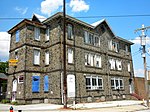Edwin Fitler Academics Plus School
1898 establishments in PennsylvaniaGermantown, PhiladelphiaGothic Revival architecture in PennsylvaniaPublic K–8 schools in PhiladelphiaSchool District of Philadelphia ... and 3 more
School buildings completed in 1898School buildings on the National Register of Historic Places in PhiladelphiaUse mdy dates from March 2020

Edwin Fitler Academics Plus School is a historic school located in the Germantown neighborhood of Philadelphia, Pennsylvania. It is part of the School District of Philadelphia. The building was built in 1897–1898 and is a 3 1/2-story, schist building in the Gothic-style. It features a projecting battlement tower, round arched openings, and three projecting gables.The building was added to the National Register of Historic Places in 1986.
Excerpt from the Wikipedia article Edwin Fitler Academics Plus School (License: CC BY-SA 3.0, Authors, Images).Edwin Fitler Academics Plus School
Keyser Street, Philadelphia
Geographical coordinates (GPS) Address Nearby Places Show on map
Geographical coordinates (GPS)
| Latitude | Longitude |
|---|---|
| N 40.0262 ° | E -75.1665 ° |
Address
Fitler School (Fitler Academics Plus)
Keyser Street
19144 Philadelphia
Pennsylvania, United States
Open on Google Maps











